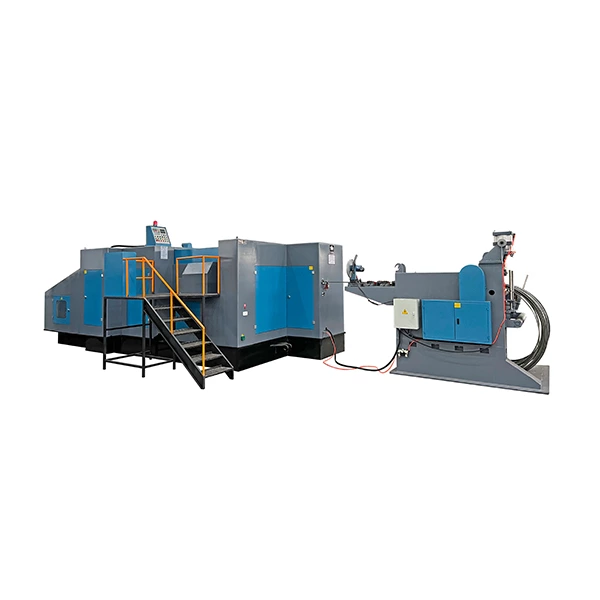Cold Heading Machining And Materials Introduction
In industrial manufacturing, bolt forging machine is increasingly becoming an important method for the production of fasteners and mass-produced metal parts due to its high efficiency, good material utilization, and excellent product mechanical properties.
This article will discuss this process from three aspects: "Operation of Processing Equipment," "Typical Material Selection," and "Practical Application Scenarios."
Overview of Processing Equipment Operation
bolt former refers to the plastic deformation of metal wire or bar stock into the desired shape using specialized cold heading equipment at temperatures below the metal's recrystallization temperature through methods such as stamping, extrusion, and ejection. This process can achieve the forming of complex parts without heating, with high die dimensional accuracy and low material loss.
Furthermore, the equipment can be equipped with multi-stage presses (e.g., up to seven forming stages) to accommodate the production needs of steel, aluminum, and copper parts with different diameters and lengths.
In actual operation, key steps include: billet feeding, die cavity positioning, ejector pin/punch impact, forming and ejection, and subsequent stages (such as chamfering or heat treatment). A well-executed cold heading process can significantly improve the tensile strength and hardness of parts, offering a clear advantage over traditional stretching processes.
Material Selection and Performance Considerations
From a materials perspective, bolt former machine has a wide range of applications, extending from low-carbon steel, alloy steel, and stainless steel to copper, aluminum, and their alloys. The following is an analysis of the applicability of several typical materials in cold heading:
-
Low-carbon steel wire or bars (such as 75–78 HRB wire) possess good plasticity and low cost, making them commonly used materials for fasteners such as bolts and pins.
-
Copper and copper alloys, and aluminum/aluminum alloys perform exceptionally well in parts requiring lightweighting or electrical/thermal conductivity.
-
Stainless steel and medium-carbon steel (carbon content below ~0.44%) can also be cold-headed after spheroidizing annealing, suitable for applications requiring corrosion resistance or higher strength.
It is worth emphasizing that bolt maker machine raw materials require high cleanliness, fine grain structure, and carbide spheroidization to ensure good plasticity, uniform deformation, and resistance to cracking. Therefore, in the material selection stage, one should not only consider the "lowest cost," but also simultaneously consider the material's cold-forming adaptability, post-processing capabilities, and the functional requirements of the final part.
Practical Application Scenarios and Value Manifestations
In industries such as automotive, machinery manufacturing, and electronic connectors, bolt making machine plays a crucial role. For example, when producing millions of bolts, rivets, or copper pillars, cold heading not only saves processing time but also achieves a material utilization rate of 80-90%. In this context, manufacturers realize value through the following:
-
High-efficiency production: Cold heading completes the geometry in one step, eliminating the need for additional heat treatment or large-scale cutting, thus reducing production cycles.
-
Cost control: Less scrap, higher raw material utilization, and the ability to directly use wire/bar stock without prior hot forging.
-
Performance improvement: Due to the low-temperature plastic deformation during processing, parts often possess higher strength and a denser microstructure. As described in the patent, the tensile strength and hardness of cold-headed parts are significantly better than those produced by tensile processing.
-
Multi-material compatibility: Cold heading can be applied to steel, aluminum, copper, and other materials, allowing for flexible material adjustments on the same production line based on product requirements.
In practical selection, the material should be chosen based on the part's function (e.g., load-bearing capacity, corrosion resistance, conductivity, thermal expansion requirements). For example, if a fastener needs to be used in a humid environment and requires high strength, low-carbon or medium-carbon stainless steel with spheroidizing annealing would be more suitable than ordinary carbon steel.
Summary
In conclusion, by rationally selecting raw materials (fully considering cold forming adaptability and part functional requirements), optimizing production processes (possessing multi-stage presses and precision molds), and covering typical application scenarios (such as automotive fasteners and large-volume copper pillars), high-efficiency, low-cost, and high-performance production goals can be achieved. Looking to the future, with the integration of materials (such as titanium alloys and lightweight high-strength aluminum alloys) and intelligent manufacturing, bolt manufacturing machine technology will play an even greater role in green manufacturing, lightweight structures, and new energy equipment.

 English
English اللغة العربية
اللغة العربية Español
Español Português
Português Русский
Русский  Türkçe
Türkçe